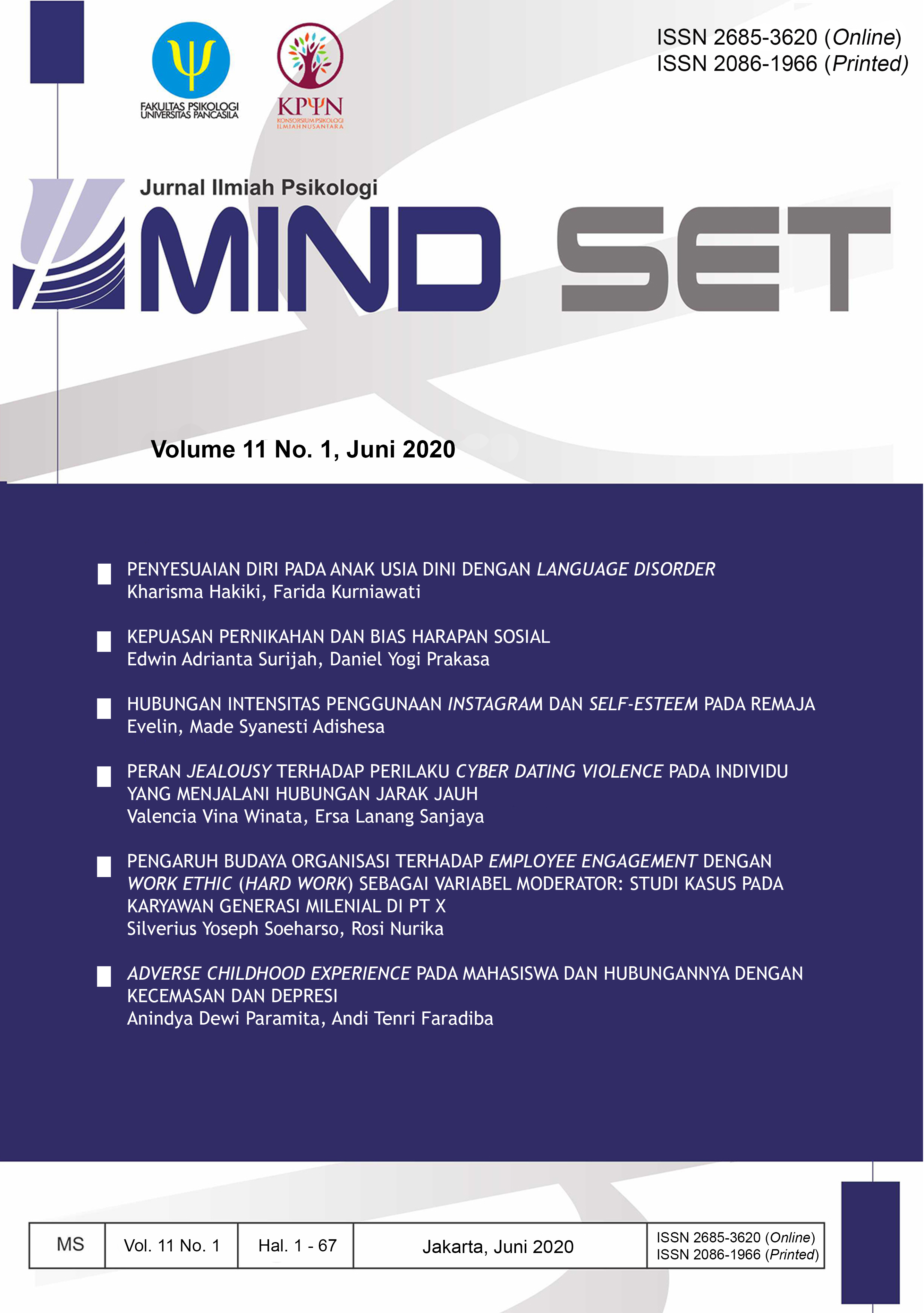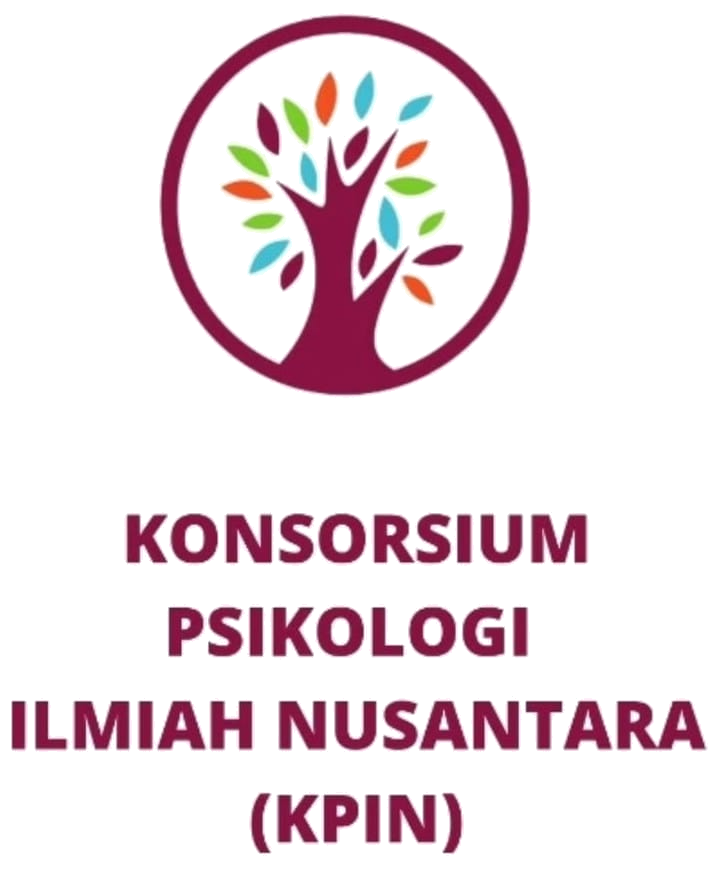Kepuasan Pernikahan dan Bias Harapan Sosial
DOI:
https://doi.org/10.35814/mindset.v11i01.1269Keywords:
marriage, marital satisfaction, social desirability biasAbstract
Marital satisfaction is a critical variable in marriage study at large. However, there is not a single study investigating the influence of social desirability bias toward participants’ responses filling in the marital satisfaction scale in the Indonesian context. This study aims to determine which marital satisfaction scale free from bias. Participants of this study were 250 married couples who filled in three different marital satisfaction scales (Satisfaction with Married Life, Relationship Assessment Scale, and Perceived Relationship Quality Component). Regression analysis examined the contribution of social desirability bias toward marital satisfaction. Results showed that Satisfaction with Married Life scale is free from social desirability bias. Meanwhile, Relationship Assessment Scale and Perceived Relationship Quality Component were influenced by the social desirability. This study hopes to contribute to the Indonesian marriage study by utilizing a social desirable bias-free scale or by statistically controlling the bias.
References
Ardhianita, I., & Andayani, B. (2005). Kepuasan pernikahan ditinjau dari berpacaran dan tidak berpacaran. Jurnal Psikologi Fakultas Psikologi Universitas Gadjah Mada, 32(2), 101-111.
Busby, D. M., Christensen, C., Crane, D. R., & Larson, J. H. (1995). A revision of the Dyadic Adjustment Scale for use with distressed and nondistressed couples: Construct hierarchy and multidimensional scales. Journal of Marital and Family Therapy, 21, 289-308. doi:10.1111/j.1752-0606.1995.tb00163.x
Cao, H., Zhou, N., Fang, X., & Fine, M. (2017). Marital well-being and depression in Chinese marriage: Going beyond satisfaction and ruling out critical confounders. Journal of Family Psychology, 31(6), 775-784. doi:https://doi.org/10.1037/fam0000312
Caputo, A. (2017). Social desirability bias in self-reported well-being measures: Evidence from an online survey. Universitas Psychologica, 16(2). doi:https://doi.org/10.11144/Javeriana.upsy16-2.sdsw
Charles, J. L. K., & Dattalo, P. V. (2018). Minimizing social desirability bias in measuring sensitive topics: The use of forgiving language in item development. Journal of Social Service Research, 44(4), 587-599. doi:10.1080/01488376.2018.1479335
Crowne, D. P., & Marlowe, D. (1960). A new scale of social desirability independent of psychopathology. Journal of Consulting Psychology, 24, 349-354.
Delattore, M. Z., & Wagner, A. (2020). Marital quality assessment: Reviewing the concept, instruments, and methods. Marriage & Family Review. doi:10.1080/01494929.2020.1712300
Fastame, M. C., & Penna, M. P. (2012). Does social desirability confound the assessment of self-reported measures of well-being and metacognitive efficiency in young and older adults? Clinical Gerontologist, 35(3), 239-256. doi:10.1080/07317115.2012.660411
Fletcher, G. J. O., Simpson, J. A., & Thomas, G. (2000). The measurement of Perceived Relationship Quality Components: A confirmatory factor analytic approach. Personality and Social Psychology Bulletin, 26(3), 340-354. doi:https://doi.org/10.1177/0146167200265007
Fowers, B. J., & Applegate, B. (1996). Marital satisfaction and conventionalization examined dyadically. Current Psychology, 15, 197-214.
Fowers, B. J., & Olson, D. H. (1993). ENRICH Marital Satisfaction Scale: A brief research and clinical tool. Journal of Family Psychology, 7(2), 176-185. doi:https://doi.org/10.1037/0893-3200.7.2.176
Funk, J. L., & Rogge, R. D. (2007). Testing the ruler with item response theory: Increasing precision of measurement for relationship satisfaction with the Couples Satisfaction Index. Journal of Family Psychology, 21(4), 572-583. doi:https://doi.org/10.1037/0893-3200.21.4.572
Grimm, P. (2010). Social Desirability Bias. In J. Sheth & N. Malhotra (Eds.), Wiley International Encyclopedia of Marketing.
Haghighat, R. (2007). The development of the Brief Social Desirability Scale (BSDS). Europe’s Journal of Psychology, 3(4). doi:https://doi.org/10.5964/ejop.v3i4.417
Hendrick, S. S. (1988). A generic measure of relationship satisfaction. Journal of marriage and the family, 50, 93-98.
Hendrick, S. S., Dicke, A., & Hendrick, C. (1998). The Relationship Assessment Scale. Journal of Social and Personal Relationships, 15(1), 137-142. doi:https://doi.org/10.1177/0265407598151009
Hermaleni, T. (2018). Perbedaan kepuasan pernikahan ditinjau dari ideologi gender pada istri yang bekerja. Jurnal Riset Aktual Psikologi Universitas Negeri Padang, 9(2), 185-194. doi:https://doi.org/10.24036/rapun.v9i2.102214
Himawan, K. K. (2017). Jealousy and relationship satisfaction among Indonesian dating adults. Psych J, 6, 328-329. doi:10.1002/pchj.195
Hunsley, J., Best, M., Lefebvre, M., & Vito, D. (2001). The seven-item short form of the Dyadic Adjustment Scale: Further evidence for construct validity. The American Journal of Family Therapy, 29(4), 325-335. doi:10.1080/01926180126501
Kazak, A. E., Jarmas, A., & Snitzer, L. (1988). The assessment of marital satisfaction: An evaluation of the Dyadic Adjustment Scale. Journal of Family Psychology, 2(1), 82-91.
Keizer, R. (2014). Relationship Satisfaction. In A. C. Michalos (Ed.), Encyclopedia of Quality of Life and Well-Being Research (pp. 5437-5443). Dordrecht: Springer Netherlands.
Larson, R. B. (2019). Controlling social desirability bias. International Journal of Market Research, 61(5), 534-547. doi:https://doi.org/10.1177/1470785318805305
Margelisch, K., Schneewind, K. A., Violette, J., & Perrig-Chiello, P. (2017). Marital stability, satisfaction and well-being in old age: Variability and continuity in long-term continuously married older persons. Aging & Mental Health, 21(4), 389-399. doi:10.1080/13607863.2015.1102197
Maroufizadeh, S., Omani-Samani, R., Almasi-Hashiani, A., Navid, B., Sobati, B., & Amini, P. (2018). The Relationship Assessment Scale (RAS) in infertile patients: A reliability and validity study. Middle East Fertility Society Journal, 23(4), 471-475. doi:https://doi.org/10.1016/j.mefs.2018.04.001
Omani-Samani, R., Maroufizadeh, S., Ghaheri, A., Amini, P., & Navid, B. (2018). Reliability and validity of the Kansas Marital Satisfaction Scale (KMSS) in infertile people. Middle East Fertility Society Journal, 23(2), 154-157. doi:https://doi.org/10.1016/j.mefs.2017.10.005
Roach, A., Frazier, L., & Bowden, S. (1981). The Marital Satisfaction Scale: Development of a measure for intervention research. Journal of Marriage and Family, 43(3), 537-546. doi:10.2307/351755
Roustaei, N., Jafari, P., Sadeghi, E., & Jamali, J. (2015). Evaluation of the relationship between social desirability and Minor Psychiatric Disorders among nurses in Southern Iran: A robust regression approach. International Journal of Community based Nursing and Midwifery, 3(4), 301-308.
Ruppanner, L., Brandén, M., & Turunen, J. (2018). Does unequal housework lead to divorce? Evidence from Sweden. Sociology, 52(1), 75-94. doi:https://doi.org/10.1177/0038038516674664
Spanier, G. (1976). Measuring Dyadic Adjustment: New scales for assessing the quality of marriage and similar dyads. Journal of Marriage and Family, 38(1), 15-28. doi:10.2307/350547
Stöber, J. (2001). The Social Desirability Scale-17 (SDS-17): Convergent validity, discriminant validity, and relationship with age. European Journal of Psychological Assessment, 17(3), 222-232. doi:https://doi.org/10.1027//1015-5759.17.3.222
Taghani, R., Ashrafizaveh, A., Soodkhori, M. G., Azmoude, E., & Tatari, M. (2019). Marital satisfaction and its associated factors at reproductive age women referred to health centers. Journal of Education and Health Promotion, 8, 133. doi:https://doi.org/10.4103/jehp.jehp_172_18
Timmons, A. C., Arbel, R., & Margolin, G. (2017). Daily patterns of stress and conflict in couples: Associations with marital aggression and family-of-origin aggression. Journal of Family Psychology : JFP : Journal of the Division of Family Psychology of the American Psychological Association (Division 43), 31(1), 93-104. doi:https://doi.org/10.1037/fam0000227
Vanlear, C. A. (1990). Communication and marital satisfaction: Social desirability and nonlinearity. Communication Research Reports, 7(1), 38-44. doi:10.1080/08824099009359852
Vaughn, M. J., & Baier, M. E. M. (1999). Reliability and validity of the relationship assessment scale. The American Journal of Family Therapy, 27(2), 137-147. doi:10.1080/019261899262023
Visschers, J., Jaspaert, E., & Vervaeke, G. (2017). Social desirability in intimate partner violence and relationship satisfaction reports: An exploratory analysis. Journal of Interpersonal Violence, 32(9), 1401-1420. doi:https://doi.org/10.1177/0886260515588922
Ward, P. J., Lundberg, N. R., Zabriskie, R. B., & Berrett, K. (2009). Measuring marital satisfaction: A comparison of the Revised Dyadic Adjustment Scale and the Satisfaction with Married Life Scale. Marriage & Family Review, 45(4), 412-429. doi:10.1080/01494920902828219












